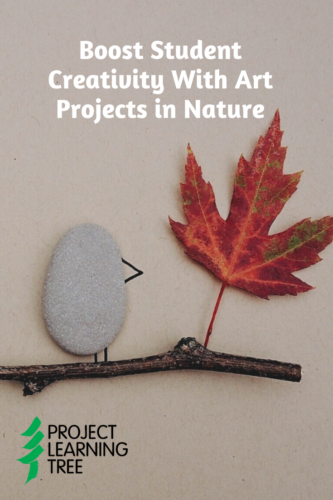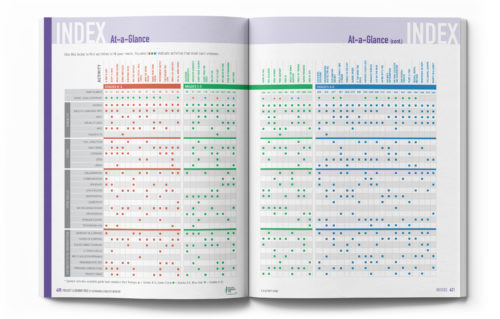 Not all projects need to be taken home for prominent placement on the fridge. Creating art in nature is about connecting with your environment, being inspired by nature, and leaving it right where it was found. These activities use tools and materials found in nature to show children that anything can be art if you’re creative enough. Rocks, sticks, logs on the forest floor, even mud after a good rain can all be turned into art.
Not all projects need to be taken home for prominent placement on the fridge. Creating art in nature is about connecting with your environment, being inspired by nature, and leaving it right where it was found. These activities use tools and materials found in nature to show children that anything can be art if you’re creative enough. Rocks, sticks, logs on the forest floor, even mud after a good rain can all be turned into art.
There’s no age range on these activities, either. Adjust activities as needed to link back to existing school content and make projects a group effort where you see fit. The point is to leave the finished products behind. Photographs are fine, especially with sensitive kids who may have a tough time with that concept.
Sun Catchers
These beautiful sun catchers are a great activity for a sunny day. Students can use the finished products to catch the light before leaving them behind. Have students gather twigs, branches, and leaves to create the standing sun catchers in a variety of shapes. The image is rectangular, but circles, ovals, even triangles can use the same concept.
Decorated Logs
Any log or tree stump will do here. On your next community walk or field trip to a nature reserve, students can gather leaves to create patterns on fallen logs. Time this one in the fall for a variety of colors and leaf shapes. This could be a fun supplement to simple math and geometry lessons back in the classroom.
You can also use this opportunity to have students count tree rings. Have them take a photo of a tree stump or better yet, draw it! The “Tree Cookie” activity from PLT’s Explore Your Environment: K-8 Activity Guide teaches students about the life of a tree – how old it is and what type of conditions it may have encountered (i.e., drought, wind, insects).
Stick Patterns
Play with patterns arranged with sticks and twigs on the forest floor. Young students may arrange sticks from shortest to tallest as they practice taking turns. Older children may alternate patterns or even create their own morse codes. As an extension activity, have students think about the different types of trees these sticks may have fallen from as they work.
Nature Squares
This activity can vary as the seasons change. Have students gather up piles of one type of natural material to create squares or other shapes filled with different colors and textures. Remind them that they shouldn’t be plucking anything but collecting materials already discarded by nature. In the fall, they can play with multi-colored leaves or separate leaves by shade.
This is a perfect complement to “The Shape of Things” activity from PLT’s Trees & Me: Activities for Exploring Nature with Young Children guide.
Photo Shoots With Leaves
Kick your students’ imaginations into overdrive with this fun leaf activity. Have them imagine scenarios and shapes they can create with leaves solo, in pairs, or in groups. This is a fun activity to share with parents at the end of the day or post on the classroom website with the appropriate permissions.
Decorating With Dandelions
Dandelions are everywhere come spring. That makes them the perfect tool for “paintings” and projects as vibrant as the flower. If you’re working with a larger classroom, have students work in groups to use dandelions in creative ways. Back in the classroom, extend the activity by talking about the changes that dandelions experience with the seasons.
Shadow Portraits
These shadow portraits only have to last as long as the students’ poses. If you’re anywhere near a beach, use seashells to add a touch of whimsy. Otherwise, any found objects work with this fun activity. Use this one as a recess alternative or spin on self-portraits in an art unit for kids of any age.
Animal Sculptures
These animal sculptures and 3D images can be as simple or intricate as you like depending on your students’ ages and needs. Students who need a little guidance may like a more paint-by-numbers approach where they fill in natural materials into set models you provide. Older students may like a more free-form approach.
Leaf Flowers
Rather than leading students through another round of paper flowers, use fallen leaves, pebbles, and twigs to help students create temporary blooms out in nature. As an alternative gift for the next Mother’s Day or spring craft project, take photos of their creations and help students create frames for the prints.
Sandprints
Sandprints using stones and shells found along the shore are a fun way to embrace visual storytelling. If you don’t have beach access, any park or even muddy area would do. Just plan accordingly and warn parents if kids might get dirty! These could be a fun tie-in for younger students after a read-aloud of stories like Jonny Lambert’s Bear and Bird: Find a Footprint.
Pebble Art
Watch students turn simple rocks, stones, and pebbles into imaginative scenes and creatures with pebble art projects. Bring along sidewalk chalk that will wash away in the next rain to allow them to add detail to their characters. This is a fun extension activity for lessons around plot and character development.
Beach Art
Teachers with access to the beach should use that to their advantage with nature art that uses typical beach materials to create animals and objects found in that environment. Students can pre-plan their projects based on their thoughts of what they may find while beachcombing or let their creativity guide them in the moment.
Nature Quilt
A nature quilt can be a perfect whole-group activity to teach cooperative skills and patterns. You can also use this one as the culmination of a unit on themes or symbolism, where each square represents something students learned in that unit. To extend things further, have students describe what they created in each square once it’s all done.
Mandalas
Mandalas can help us teach about geometry, patterns, even meditation practices for older kids. These mandalas support the idea of nature as the great equalizer. Even students with fine motor difficulties have the ability to participate in their creation when they’re allowed to vary their mandalas in sizes, patterns, and shapes.
Tree Mud Monsters
We already know kids love playing in the mud. After the next rainy day, take the students out to the nearest forest preserve or park to create mud boys, girls, and monsters on tree trunks using mud and other natural materials. The activity below suggests store-bought air-dry clay as an alternative to natural mud, but we always recommend leaving nature the way you found it.
Fairy Houses
Help students house their resident fairies, gnomes, and forest sprites for the changing seasons with this whimsical activity. This one can even work with older students if you’re exploring reading units about legends and myths. Bump up the standards on the finished products for an added challenge with your older students.
Nature Art Frames
Help students create frames of their favorite shape — or of shapes relevant to a classroom lesson — as something they can use on their next outdoor outing. Allow them to take the lead on images they choose to “frame” within those models. These are the only project on this list they can take with them, even if the images inside are left only to their memories.
These art projects in nature are all about tapping into your students’ creative spirits. You know your classroom best. Adjust any activities based on students’ learning styles and interest areas. Adapt activities to what your students are already learning as part of their everyday curriculum, or use these activities as brain breaks.
 Did you know? Many PLT activities incorporate art!
Did you know? Many PLT activities incorporate art!
Check out the “At-a-Glance” Index on pages 420-421 in the Explore Your Environment: K-8 Activity Guide. There’s a handy “Subject” section that highlights which subjects are covered within each activity.
In the Trees & Me: Activities for Exploring Nature with Young Children guide, you’ll find fun art experiences for little learners in the “Free Exploration” section of each activity.


